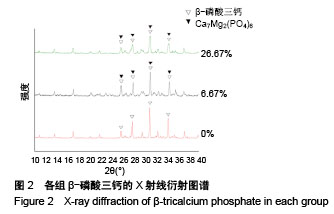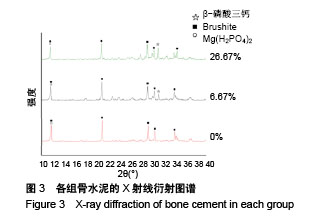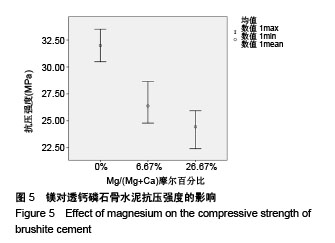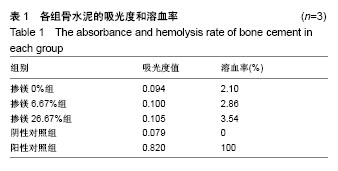| [1] Gbureck U,Dembski S,Thull R,et al.Factors influencing calcium phosphate cement shelf-life. Biomaterials. 2005; 26(17):3691-3697.[2] Mirtchi AA,Lemaître J,Munting E.Calcium phosphate cements: study of the β-tricalcium phosphate- dicalcium phosphate- calcite cements.Biomaterials.1990;11(2):83-88.[3] Tamimi F,Kumarasami B,Doillon C,et al.Brushite–collagen composites for bone regeneration. Acta Biomaterialia. 2008; 4(5):1315-1321.[4] Flautre B,Lemaître J,Maynou C,et al.Influence of polymeric additives on the biological properties of brushite cements: An experimental study in rabbit.J Biomed Mater Res A. 2003; 66(2):214-223.[5] Lagazzo A,Barberis F,Carbone C,et al.Molecular level interactions in brushite-aminoacids composites.Mater Sci Eng C Mater Biol Appl.2017;70(Pt 1):721-727.[6] 王海霞,岳进.梯度掺锶羟基磷灰石骨水泥的体外细胞生物学性能[J].中国组织工程研究,2013, 17(47):8149-8154.[7] 员丽颖.透钙磷石涂层浸提液溶入不同浓度锶后联合应用的生物学评价[D].河北联合大学,2014.[8] 王买全,李运峰.微量元素锶与骨质疏松症[J].中国骨质疏松杂志, 2014,20(10):1258-1262.[9] 高麒,牛强,李永锋,等.掺锶仿生涂层用于促进种植体早期骨结合的初步研究[J].牙体牙髓牙周病学杂志, 2014,24(4):216-220.[10] Sopcak T,Medvecky L,Giretova M,et al.Effect of phase composition of calcium silicate phosphate component on properties of brushite based composite cements.Mater Charact.2016;117:17-29.[11] Pina S,Vieira SI,Torres PM,et al.In vitro performance assessment of new brushite-forming Zn-and ZnSr-substituted beta-TCP bone cements.J Biomed Mater Res B Appl Biomater.2010;94(2):414-420. [12] 顾雪梅,安燕,杨雪艳,等.含锶纳米羟基磷灰石的制备及性能研究[J].无机盐工业,2015,47(1):30-32.[13] Jallot E,Nedelec JM,Grimault AS,et al.STEM and EDXS characterisation of physico-chemical reactions at the periphery of sol-gel derived Zn-substituted hydroxyapatites during interactions with biological fluids.Colloids Surf B Biointerfaces.2005;42(3-4):205-210.[14] 周秋娟,梁永强,李淑静,等.掺锶透钙磷石骨水泥修复家兔牙槽骨缺损的研究[J].安徽医科大学学报,2017, 52(4):589-592.[15] 李昊妍.掺锶透钙磷石钛种植体体内骨整合的实验研究[D].华北理工大学,2015.[16] 李忻畅.掺锶透钙磷石涂层对骨质疏松大鼠种植支抗骨整合影响[D].华北理工大学,2016.[17] 刘巧巧.透钙磷石涂层掺锶对ME3T3-E1细胞的增殖、分化影响[D].河北联合大学,2014.[18] 闫玉婷,李忻畅,田景瑞,等.掺锶10%透钙磷石骨水泥修复兔下颌牙槽骨缺损的效果[J].郑州大学学报医学版, 2016,51(5): 614-617.[19] Kotsar A,Nieminen R,Isotalo T,et al.Biocompatibility of new drug-eluting biodegradable urethral stent materials. Urology. 2010;75(1):229-234.[20] GB/T16886.12-2005.医疗器械生物学评[S].[21] 赵勤富,郑力,王思玲.纳米多孔羟基磷灰石的制备方法及其在药物载体方面应用的研究进展[J].沈阳药科大学学报,2010, 27(12):1009-1013.[22] Apelt D,Theiss F,El-Warrak AO,et al.In vivo behavior of three different injectable hydraulic calcium phosphate cements. Biomaterials.2004;25(7):1439-1451.[23] Liang Y,Li H, Xu J,et al.Morphology, composition, and bioactivity of strontium-doped brushite coatings deposited on titanium implants via electrochemical deposition.Int J Mol Sci.2014;15(6):9952-9962.[24] 侯光辉.透钙磷石复合材料修复动物骨缺损的初步实验研究[D].中南大学,2010. [25] Barralet JE,Grover LM,Gbureck U.Ionic modification of calcium phosphate cement viscosity. Part II: hypodermic injection and strength improvement of brushite cement. Biomaterials.2004;25(11):2197-2203. [26] 孙俊芬,曹伟烨,马冰冰.掺镁羟基磷灰石的合成及对蛋白质吸附性能的影响[J].离子交换与吸附,2014,30(1):20-28. [27] 闫玉婷.掺锶透钙磷石骨水泥修复牙槽骨缺损的实验研究[D].华北理工大学,2016.[28] 杨迪诚,钟建,刘涛,等.透钙磷石骨水泥制备及其载药性能[J].中国组织工程研究,2015,19(3):427-433.[29] Engstrand J,Persson C,Engqvist H.The effect of composition on mechanical properties of brushite cements.J Mech Behav Biomed Mater.2014;29(1):81-90.[30] Kwon SH,Jun YK,Hong SH,et al.Synthesis and dissolution behavior of β-TCP and HA/β-TCP composite powders.J Eur Ceram Soc.2003;23(7):1039-1045.[31] Lin FH,Liao CJ,Chen KS,et al.Petal-like apatite formed on the surface of tricalcium phosphate ceramic after soaking in distilled water.Biomaterials.2001;22(22):2981-2992.[32] 王端诚,颜廷亭,黄明华,等.掺镁羟基磷灰石晶须的制备与研究[J].人工晶体学报,2014,43(3):648-651.[33] 李星逸,马野,袁世丹.多孔含镁羟基磷灰石的烧结行为及其组织结构[J].中国体视学与图像分析, 2015,20(4):392-399.[34] Bohner M,Gbureck U.Thermal reactions of brushite cements.J Biomed Mater Res B Appl Biomater. 2008;84(2): 375-385.[35] Gbureck U,Barralet JE,Spatz K,et al.Ionic modification of calcium phosphate cement viscosity. Part I: hypodermic injection and strength improvement of apatite cement. Biomaterials.2004;25(11):2187-2195.[36] Huang J,Ren Y, hang B,et al.Study on Biocompatility of Magnesium and Its Alloys.Rare Metal Mater Eng. 2007;36(6): 1102-1105.[37] Cabrejos-Azama J,Alkhraisat MH,Rueda C,et al.Magnesium substitution in brushite cements for enhanced bone tissue regeneration.Mater Sci Eng C Mater Biol Appl. 2014;43: 403-410.[38] Alkhraisat MH,Cabrejos-Azama J,Rodríguez CR,et al. Magnesium substitution in brushite cements. Mater Sci Eng C Mater Biol Appl.2013;33(1):475-481. |
.jpg)







.jpg)
.jpg)